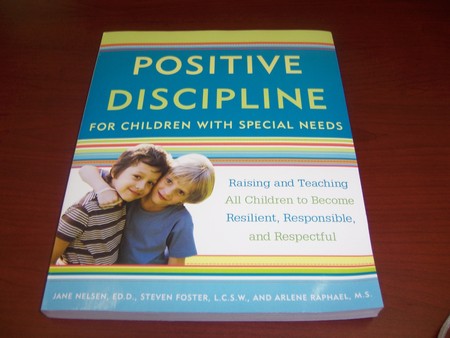Discipline is a difficult and important aspect of child rearing – for kids with and without special needs. So when I ran across Jane Nelsen’s new book, Positive Discipline for Children with Special Needs, and read the subtitle – Raising and Teaching All Children to Become Resilient, Responsible, and Respectful – I was hooked. After all, who doesn’t want their kids to be resilient, responsible, and respectful?
The Positive Discipline Philosophy
Positive Discipline is based on Alfred Adler’s work. The philosophy is explained this way in the book’s introduction. “It is an approach to child rearing and teaching that emphasized helping children learn valuable social and life skills that will help them make responsible decisions that lead to a more productive and satisfying life.” Rather than relying upon traditional punishments and rewards, Positive Discipline uses tools grounded “in mutual respect, empathetic understanding, understanding the child’s point of view, and effective communication that encourages children to solve problems.”
What’s In the Book
Positive Discipline for Children With Special Needs is divided into 13 chapters. The first chapter gives background information about Positive Discipline. Chapter 2 discusses “misbehavior” and “innocent behavior,” Chapter 3 focuses on problem solving and the brain, and Chapter 4 explains positive time out. Chapters 5 – 12 flesh out the theories presented by applying them to one case study per chapter. Chapter 13 summarizes the tools presented throughout the book and suggests how to adapt them for kids with special needs.
The Positives in Positive Discipline
This book and the theories it promotes have many positives.
- First, it’s reading level is approachable for parents and teachers. Nelsen keeps the educational jargon to a minimum and revisits ideas and strategies so readers have time to absorb them.
- Second, the emphasis on respect for kids is compassionate and biblical.
- Third, parents and teachers are encouraged to observe and listen to kids rather than treat them like widgets on a conveyor belt. This is not one-size-fits-all discipline, but disciplines that encourages parents and teachers to observe students and adjust discipline to their needs.
- Fourth, the emphasis is on a gradual shifting of responsibility from adult to child so the child becomes responsible for his behavior.
- Fifth, the authors provide suggestions on how to adapt the program for children with developmental delays, communication disorders, and behavior issues.
- Sixth, the authors provide an easy-to-read summary chart and lots of practice using it.
- Finally, this theory emphasizes the need for adults to understand and alter their reactions to a child’s behavior, along with changing the child’s behavior.
The Drawbacks to Positive Discipline
The main drawback to this approach is the one-on-one time it requires. For families with more than one child implementing the strategies presented may be difficult. For regular classroom teachers in charge of 20 – 30 students it may be impossible. For special education classroom teachers with lower teacher to student ratios, it might work. In any case, the book is worth reading, because it’s full of ideas for parents and educators to glean and adapt to their circumstances.
What’s Your Experience?
Positive Discipline for Children With Special Needs is the latest in a string of titles by the Positive Discipline group. In addition to books, they have CDs, DVDs, and offer Positive Discipline workshops. If you’ve had experience with their products, please leave a comment about them. What worked for you? What didn’t? Would you recommend them to others?
Do you like what you see at DifferentDream.com? You can receive more great content by subscribing to the quarterly Different Dream newsletter and signing up for the daily RSS feed delivered to your email inbox. You can sign up for the first in the pop up box and the second at the bottom of this page.




Thank!
Jolene
Oh, Jolene! Wonderful! One of our greatest challenges as the parents of a child with hemophilia was approaching discipline without spanking. This looks so helpful on many different levels despite the time it requires. Thanks for all you do!
Not a Christian perspective, but it’s based on the biblical tenants modeled by Christ: respect for others, empathy, not condoning harmful behaviors, the need for belonging, etc.
So far, at the glorious age of 5, we have had tremendous “luck” with using the concept of “first this, then that”, “being kind” and “friends help friends”….I’m sure we will encounter more challenges as we go (and we still have meltdowns), but so far this is working…
I was so happily surprised when my daughter witnessed two cartoon characters quarreling with one another on TV and said to the characters “we need to be kind to our friends”
Modeling and talking things through is so important!!!
Is the book based on a Christian perspective?